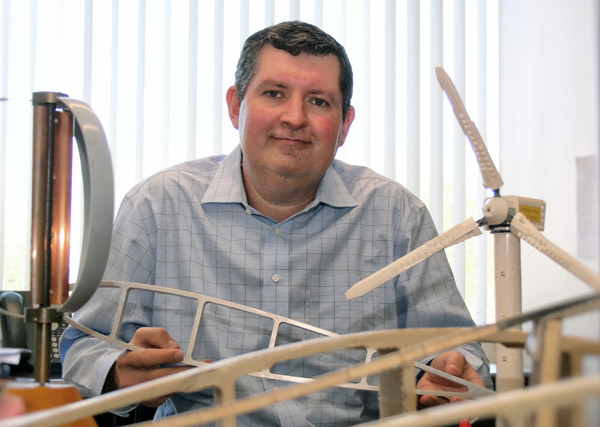Mechanical Engineer Helps Propel Progress of Giant Wind Turbine
By: Melissa Cutler | Dec. 6, 2018
A UT Dallas professor is part of a team designing the world’s biggest wind turbine with blades more than 200 meters long. In October, the team tested two smaller-blade prototypes at the National Renewable Energy Laboratory’s wind technology center in Golden, Colorado. Watch a crew install a prototype blade on a turbine in this time-lapse video. If you don’t see the clip, watch it on Vimeo. (Video by Advanced Research Projects Agency-Energy)
When Dr. Todd Griffith sees palm trees swaying in the wind, he doesn’t think it’s time to kick back with a piña colada. The associate professor of mechanical engineering at The University of Texas at Dallas instead thinks about efficiency.
“I’m thinking how efficient it is when powerful winds blow. The fronds are flexible; they fold up in hurricane-force winds for protection. When they unfold, they’re fine. I wonder if I can use that in a wind turbine,” he said.
Before joining the faculty of the Erik Jonsson School of Engineering and Computer Science last year, Griffith was a principal member of the technical staff and offshore wind technical lead at Sandia National Laboratories’ Wind Energy Technologies department. He has been a key member of a multi-institutional collaboration, led by the University of Virginia, to design and build a 50-megawatt offshore wind turbine roughly six times more powerful than the biggest one on record off the coast of Scotland.
Funded by a grant from the U.S. Department of Energy’s Advanced Research Projects Agency-Energy program, the collaboration also includes researchers at the University of Illinois at Urbana-Champaign, University of Colorado Boulder, Colorado School of Mines and the National Renewable Energy Laboratory (NREL).

“We’re designing the world’s biggest wind turbine. Where else would you do it but Texas? Everything is bigger in Texas.”
Dr. Todd Griffith, associate professor of mechanical engineering
Since arriving at UT Dallas, Griffith has continued his role in the project, working on the designs of blades over 200 meters long, more than the length of two football fields. Typical blades are about one-quarter that size.
“We’re designing the world’s biggest wind turbine,” Griffith said. “Where else would you do it but Texas? Everything is bigger in Texas.”
The massive turbine marks an about-face from conventional wind turbine design. The standard wind turbine is a three-bladed machine positioned with the blades facing incoming winds. The blades for the new concept, called a Segmented Ultralight Morphing Rotor (SUMR) wind turbine, would face downwind.
“If you build a wind turbine offshore, whether it’s in the Atlantic Ocean or the Gulf of Mexico, you’re going to have a hurricane event,” he said. “Wind speeds can reach over 200 mph. That’s why we designed the turbine to perform the way palm trees perform and ride out a hurricane. They bend but don’t break.
“When wind speeds get really high, the turbine will stop operating. The blades align themselves to reduce cantilever forces through a trunnion hinge that responds to changes in wind speed. A hinge near the hub would allow the blades to fully fold and collapse in hurricane-force winds. Each blade will be built in four to five segments and assembled at the project site. This is the segmentation aspect. Project managers won’t have to figure out how to transport blades as long as two football fields.”
Testing the Palm-Tree-Inspired Technology
In October, the research team tested two smaller-blade prototypes on a 12-story turbine tower at NREL’s National Wind Technology Center in Golden, Colorado.
“The SUMR-Demonstrator blades were designed to mimic a full-scale 13.2 MW offshore wind turbine of the future having 105-meter blades,” Griffith said. “They’re about 70 feet long, or the size of a seven-story building if it were horizontal. We’re able to bring certain characteristics down to the one-fifth scale, where we can do the test very cost-effectively.”
After testing in Colorado, Griffith said there are plans to assess the prototype inside UT Dallas’ new subsonic wind tunnel, where wind speeds can reach 115 mph, and in the lab in the new Engineering and Computer Science West building.
Touching Lives in Coastal Areas
Because much of the country’s population lives in coastal areas, Griffith said the giant turbines could be stationed roughly 10 to 20 miles off the coast. He said those who live closer to where power is generated often have cheaper electric bills.
“If you want cost-effective electricity from renewable energy, offshore wind is probably your best option in most of the U.S. coastal states,” he said. “For example, solar energy requires a lot of land, and that’s a challenge in populated areas such as the northeastern part of the country.”
The research team is targeting a 50 percent cost reduction to produce offshore wind energy by 2025. Decreased expenditures would be realized through the use of cheaper materials and the size of the blades.
“Materials used to build wind turbine blades are similar to those used in shipbuilding,” Griffith said. “Fiberglass, carbon fiber and balsa wood are utilized most frequently. The challenge is keeping expenses down as you build bigger and bigger blades.
“The amount of energy captured from a wind turbine depends on the wind speed, the size of the hub at the center of the turbine and the length of the blades. The longer the blade, the greater the amount of energy that can be extracted from the wind.”

The SUMR-Demonstrator blades, about 70 feet long, were designed to simulate a full-scale offshore wind turbine that would have blades nearly 350 feet long, Griffith said. There are plans to evaluate the prototype at UT Dallas. (Photo by National Renewable Energy Laboratory)
Media Contact:
Melissa Cutler, UT Dallas, 972-883-4319, melissa.cutler@utdallas.edu, or the Office of Media Relations, UT Dallas, (972) 883-2155, newscenter@utdallas.edu.





